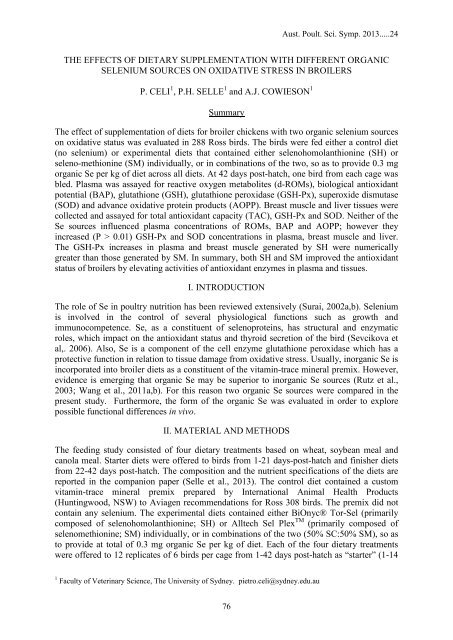APSS 2013 Proceedings - The University of Sydney
APSS 2013 Proceedings - The University of Sydney
APSS 2013 Proceedings - The University of Sydney
You also want an ePaper? Increase the reach of your titles
YUMPU automatically turns print PDFs into web optimized ePapers that Google loves.
Aust. Poult. Sci. Symp. <strong>2013</strong>.....24<br />
THE EFFECTS OF DIETARY SUPPLEMENTATION WITH DIFFERENT ORGANIC<br />
SELENIUM SOURCES ON OXIDATIVE STRESS IN BROILERS<br />
P. CELI 1 , P.H. SELLE 1 and A.J. COWIESON 1<br />
Summary<br />
<strong>The</strong> effect <strong>of</strong> supplementation <strong>of</strong> diets for broiler chickens with two organic selenium sources<br />
on oxidative status was evaluated in 288 Ross birds. <strong>The</strong> birds were fed either a control diet<br />
(no selenium) or experimental diets that contained either selenohomolanthionine (SH) or<br />
seleno-methionine (SM) individually, or in combinations <strong>of</strong> the two, so as to provide 0.3 mg<br />
organic Se per kg <strong>of</strong> diet across all diets. At 42 days post-hatch, one bird from each cage was<br />
bled. Plasma was assayed for reactive oxygen metabolites (d-ROMs), biological antioxidant<br />
potential (BAP), glutathione (GSH), glutathione peroxidase (GSH-Px), superoxide dismutase<br />
(SOD) and advance oxidative protein products (AOPP). Breast muscle and liver tissues were<br />
collected and assayed for total antioxidant capacity (TAC), GSH-Px and SOD. Neither <strong>of</strong> the<br />
Se sources influenced plasma concentrations <strong>of</strong> ROMs, BAP and AOPP; however they<br />
increased (P > 0.01) GSH-Px and SOD concentrations in plasma, breast muscle and liver.<br />
<strong>The</strong> GSH-Px increases in plasma and breast muscle generated by SH were numerically<br />
greater than those generated by SM. In summary, both SH and SM improved the antioxidant<br />
status <strong>of</strong> broilers by elevating activities <strong>of</strong> antioxidant enzymes in plasma and tissues.<br />
I. INTRODUCTION<br />
<strong>The</strong> role <strong>of</strong> Se in poultry nutrition has been reviewed extensively (Surai, 2002a,b). Selenium<br />
is involved in the control <strong>of</strong> several physiological functions such as growth and<br />
immunocompetence. Se, as a constituent <strong>of</strong> selenoproteins, has structural and enzymatic<br />
roles, which impact on the antioxidant status and thyroid secretion <strong>of</strong> the bird (Sevcikova et<br />
al,. 2006). Also, Se is a component <strong>of</strong> the cell enzyme glutathione peroxidase which has a<br />
protective function in relation to tissue damage from oxidative stress. Usually, inorganic Se is<br />
incorporated into broiler diets as a constituent <strong>of</strong> the vitamin-trace mineral premix. However,<br />
evidence is emerging that organic Se may be superior to inorganic Se sources (Rutz et al.,<br />
2003; Wang et al., 2011a,b). For this reason two organic Se sources were compared in the<br />
present study. Furthermore, the form <strong>of</strong> the organic Se was evaluated in order to explore<br />
possible functional differences in vivo.<br />
II. MATERIAL AND METHODS<br />
<strong>The</strong> feeding study consisted <strong>of</strong> four dietary treatments based on wheat, soybean meal and<br />
canola meal. Starter diets were <strong>of</strong>fered to birds from 1-21 days-post-hatch and finisher diets<br />
from 22-42 days post-hatch. <strong>The</strong> composition and the nutrient specifications <strong>of</strong> the diets are<br />
reported in the companion paper (Selle et al., <strong>2013</strong>). <strong>The</strong> control diet contained a custom<br />
vitamin-trace mineral premix prepared by International Animal Health Products<br />
(Huntingwood, NSW) to Aviagen recommendations for Ross 308 birds. <strong>The</strong> premix did not<br />
contain any selenium. <strong>The</strong> experimental diets contained either BiOnyc® Tor-Sel (primarily<br />
composed <strong>of</strong> selenohomolanthionine; SH) or Alltech Sel Plex TM (primarily composed <strong>of</strong><br />
selenomethionine; SM) individually, or in combinations <strong>of</strong> the two (50% SC:50% SM), so as<br />
to provide at total <strong>of</strong> 0.3 mg organic Se per kg <strong>of</strong> diet. Each <strong>of</strong> the four dietary treatments<br />
were <strong>of</strong>fered to 12 replicates <strong>of</strong> 6 birds per cage from 1-42 days post-hatch as “starter” (1-14<br />
1 Faculty <strong>of</strong> Veterinary Science, <strong>The</strong> <strong>University</strong> <strong>of</strong> <strong>Sydney</strong>. pietro.celi@sydney.edu.au<br />
76
















